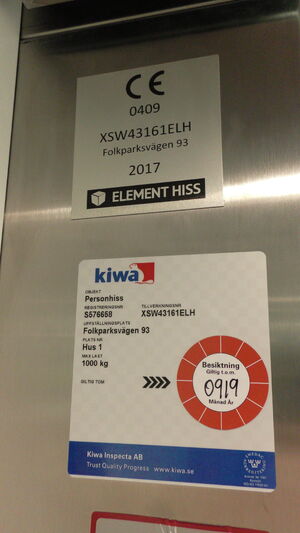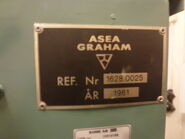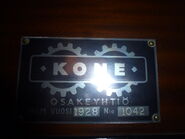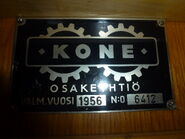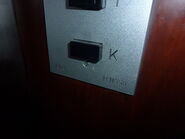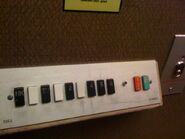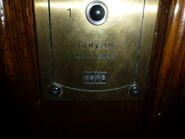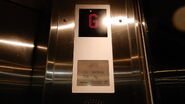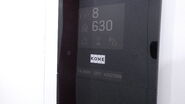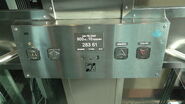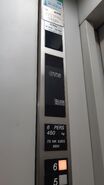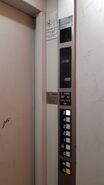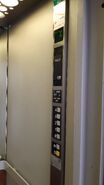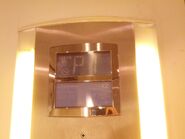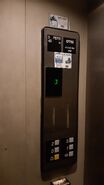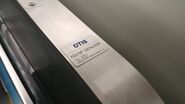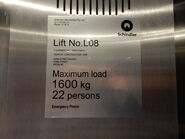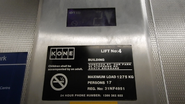УЧЕТНЫЕ И РЕГИСТРАЦИОННЫЕ НОМЕРА ЛИФТОВ.
в ЧЕМ РАЗНИЦА?
Учетный и регистрационный номер лифта (эскалатора, подъемной платформы для инвалидов)
1. Учетный номер
С августа 2017 года Ростехнадзор производит учет лифтов, эскалаторов и подъемных платформ для и инвалидов. Учет производится Ростехнадзором в реесте, путем присвоения учетного номера, который указывается в письме-уведомлении, которое Ростехнадзор направляет владельцу лифта. Требование о необходимости учета лифта установлено пунктом 3 Постановления Правительства РФ от 24 июня 2017 г. № 743 “Об организации безопасного использования и содержания лифтов, подъемных платформ для инвалидов, пассажирских конвейеров (движущихся пешеходных дорожек), эскалаторов, за исключением эскалаторов в метрополитенах”.
При смене владельца лифта, эскалатора, подъемника для инвалидов ему (лифту и т.д.) присваивается новый учетный номер. Не забывайте, что если Вы стали новым владельцем лифта (смена владельца здания, смена управляющей организации жилого дома и т.п.), то Вы должны по новой произвести учет лифта в Ростехнадзоре
2. Регистрационный номер
Еще со времен прошлого века Ростехнадзор (ранее он имел несколько других названий) производил регистрацию находящихся в эксплуатации лифтов и присваивал лифтам регистрационные номера. При регистрации лифта в его паспорт инспектором проставлялся штамп и вписывался (либо тоже проставлялся штампом) регистрационный номер. Какое-то время, до 2017 года, Ростехнадзор не вел регистрацию лифтов. В настоящее время регистрационные номера не «действуют», никакого применения не имеют, остались как историческое напоминание перемен в жизни лифтов.
3. Заводской номер
Заводской номер лифту, эскалатору, подъемной платформе для и инвалидов присваивается на предприятии-изготовителе один раз при производстве и изменению в процессе эксплуатации не подлежит, указывается на самом изделии и в паспорте.
Реестр уведомлений о начале осуществления юридическими лицами и индивидуальными предпринимателями работ по монтажу, демонтажу, эксплуатации, в том числе обслуживание и ремонт лифтов, подъемных платформ для инвалидов, пассажирских конвейеров (движущихся пешеходных дорожек), эскалаторов, за исключением эскалаторов в метрополитенах
Территориальное управление Ростехнадзора, осуществившее учет уведомления:
Межрегиональное технологическое управление Федеральной службы по экологическому, технологическому и атомному надзору
Общество с ограниченной ответственностью «Иновационно-консалтинговая компания»
ОГРН: 5147746024421 Уведомление № 01-00003 (от 2018-11-15)
Общество с ограниченной ответственностью «Лсс-Прогресс»
ОГРН: 1137746066974 Уведомление № 01-00004 (от 2018-11-15)
Акционерное общество Туристские гостиничные комплексы «Измайлово»
ОГРН: 1027700216158 Уведомление № 01-00006 (от 2018-11-26)
Государственное бюджетное учреждение здравоохранения города Москвы «Городская клиническая больница имени Д.Д. Плетнёва Департамента здравоохранения города Москвы»
ОГРН: 1037739441651 Уведомление № 01-00007 (от 2018-11-28)
Общество с ограниченной ответственностью «Современные Бизнес Системы»
ОГРН: 1167746544096 Уведомление № 01-00009 (от 2018-12-07)
Общество с ограниченной ответственностью «Орион Спец Монтаж»
ОГРН: 1037728052009 Уведомление № 01-00010 (от 2018-12-07)
Общество с ограниченной ответственностью «СигнаЛ»
ОГРН: 1187746018570 Уведомление № 01-00011 (от 2018-12-10)
Общество с ограниченной ответственностью «ГорСнаб»
ОГРН: 1177746221960 Уведомление № 01-00013 (от 2018-12-10)
Акционерное общество «Красная Пресня»
ОГРН: 1027700230755 Уведомление № 01-00014 (от 2018-12-14)
Общество с ограниченной ответственностью «Группа компаний «ВиТэрна»
ОГРН: 5157746078859 Уведомление № 01-00015 (от 2018-12-17)
Общество с ограниченной ответственностью «Техно ЛК»
ОГРН: 1127747126869 Уведомление № 01-00017 (от 2018-12-24)
Общество с ограниченной ответственностью «Ялфрэ»
ОГРН: 1127746143030 Уведомление № 01-00018 (от 2018-12-24)
Общество с ограниченной ответственностью «Орион Коммерц»
ОГРН: 1087746893002 Уведомление № 01-00019 (от 2018-12-24)
Федеральное казенное учреждение «Государственное учреждение по эксплуатации административных зданий и дачного хозяйства Министерства финансов Российской Федерации»
ОГРН: 1027700090780 Уведомление № 01-00024 (от 2019-01-10)
Общество с ограниченной ответственностью «Портал»
ОГРН: 5167746241141 Уведомление № 01-00029 (от 2019-01-28)
Общество с ограниченной ответственностью «Премиум Сервис»
ОГРН: 1107746315115 Уведомление № 01-00031 (от 2019-01-30)
Открытое акционерное общество «Царицыно»
ОГРН: 1027700321274 Уведомление № 01-00037 (от 2019-02-01)
Общество с ограниченной ответственностью «Виста-Сервис»
ОГРН: 5077746763947 Уведомление № 01-00042 (от 2019-02-06)
Общество с ограниченной ответственностью «СпецСервис Комфорт»
ОГРН: 1175007016227 Уведомление № 01-00045 (от 2019-02-07)
Общество с ограниченной ответственностью «Трансстройтехнология»
ОГРН: 1037739109088 Уведомление № 01-00051 (от 2019-02-12)
Общество с ограниченной ответственностью Ремонтно-Строительное предприятие «Витта»
ОГРН: 1037739145201 Уведомление № 01-00053 (от 2019-02-13)
Общество с ограниченной ответственностью «Проф Триумф»
ОГРН: 1167746440784 Уведомление № 01-00055 (от 2019-02-14)
Общество с ограниченной ответственностью «Псп-Телеком»
ОГРН: 1177746267995 Уведомление № 01-00057 (от 2019-02-15)
Общество с ограниченной ответственностью «Центрсервис»
ОГРН: 1067746621403 Уведомление № 01-00064 (от 2019-02-18)
Общество с ограниченной ответственностью Холдинг «Центрсервис»
ОГРН: 1167746761775 Уведомление № 01-00065 (от 2019-02-18)
Общество с ограниченной ответственностью «Эмикатех»
ОГРН: 5167746470623 Уведомление № 01-00060 (от 2019-02-18)
Общество с ограниченной ответственностью «Эмика Техник»
ОГРН: 1097746461713 Уведомление № 01-00061 (от 2019-02-18)
Общество с ограниченной ответственностью «МЭТэКС»
ОГРН: 1107746707364 Уведомление № 01-00066 (от 2019-02-19)
Индивидуальный предприниматель Морозов Сергей Александрович
ОГРН: 316774600451151 Уведомление № 01-00067 (от 2019-02-20)
Индивидуальный предприниматель Передерий Сергей Иванович
ОГРН: 318505300075571 Уведомление № 01-00068 (от 2019-02-20)
Общество с ограниченной ответственностью «Экол Строй»
ОГРН: 1167746778320 Уведомление № 01-00069 (от 2019-02-20)
Индивидуальный предприниматель Мещеряков Дмитрий Игорьевич
ОГРН: 317502700043861 Уведомление № 01-00076 (от 2019-02-21)
Общество с ограниченной ответственностью «Ореол»
ОГРН: 1047796467421 Уведомление № 01-00077 (от 2019-02-21)
Акционерное общество «Экспоцентр»
ОГРН: 1027700167153 Уведомление № 01-00078 (от 2019-02-22)
Акционерное общество «Торговый Дом ГУМ»
ОГРН: 1027739098287 Уведомление № 01-00084 (от 2019-02-25)
Общество с ограниченной ответственностью «Проекттехстрой»
ОГРН: 5077746956986 Уведомление № 01-00085 (от 2019-02-25)
Общество с ограниченной ответственностью «НЛ партнерство»
ОГРН: 1137746233283 Уведомление № 01-00086 (от 2019-02-25)
Общество с ограниченной ответственностью «Вершина»
ОГРН: 1047796377188 Уведомление № 01-00088 (от 2019-02-26)
Общество с ограниченной ответственностью «Вершина»
ОГРН: 107746851574 Уведомление № 01-00089 (от 2019-02-26)
Государственное бюджетное учреждение города Москвы по ремонту и эксплуатации инженерны сооружений «Гормост»
ОГРН: 5117746071119 Уведомление № 01-00091 (от 2019-02-26)
Индивидуальный предприниматель Кавун Андрей Викторович
ОГРН: 317505000040064 Уведомление № 01-00092 (от 2019-02-26)
Индивидуальный предприниматель Козлов Сергей Владимирович
ОГРН: 317774600599660 Уведомление № 01-00093 (от 2019-02-26)
Общество с ограниченной ответственностью Управляющая компания «ДомСервис»
ОГРН: 5067746665410 Уведомление № 01-00101 (от 2019-02-27)
Управление Ростехнадзора информирует о необходимости организации системы диспетчерского контроля за работой лифтов или обеспечения присутствия лифтера на объекте для осуществления постоянного контроля за работой лифтов квалифицированным персоналом, а также разъясняет порядок приема (ввода в эксплуатацию) вновь смонтированного лифтового оборудования в новостройках и необходимость постановки на учет вводимых в эксплуатацию лифтов в государственном реестре.
I. Об организации системы диспетчерского контроля за работой лифтов.
«Правила организации безопасного использования и содержания лифтов, подъемных платформ для инвалидов, пассажирских конвейеров (движущихся пешеходных дорожек) и эскалаторов, за исключением эскалаторов в метрополитенах», утвержденные Постановлением Правительства РФ от 24.06.2017 № 743 (далее – Правила) вступили в силу с 30.08.2017. Настоящие Правила устанавливают требования к организации безопасного использования и содержания лифтов, подъемных платформ для инвалидов, пассажирских конвейеров (движущихся пешеходных дорожек) и эскалаторов, за исключением эскалаторов в метрополитенах (далее – объекты).
Согласно пункта 3 Правил:
«система диспетчерского (операторского) контроля» – система технических средств для дистанционного контроля за работой объекта и устройств безопасности объекта, а также для обеспечения двусторонней переговорной связи между объектом и диспетчерским (операторским) пунктом;
«квалифицированный персонал» – физические лица, соответствующие квалификационным требованиям для осуществления трудовой функции, необходимой при выполнении соответствующего вида (видов) работ по монтажу, демонтажу, эксплуатации, в том числе обслуживанию и ремонту, техническому освидетельствованию и обследованию объекта, в соответствии с положениями профессиональных стандартов, устанавливающих квалификационные характеристики для выполнения соответствующих видов работ, подтвердившие соответствие своей квалификации в порядке, предусмотренном Федеральным законом «О независимой оценке квалификации».
В соответствии с пунктом 20 Правил:
«20. Контроль за работой лифтов должен осуществляться в соответствии с сопроводительной документацией объекта и руководством (инструкцией) по эксплуатации систем диспетчерского (операторского) контроля (при наличии) по выбору владельца лифта посредством:
а) диспетчерского контроля;
б) постоянного контроля за работой лифта квалифицированным персоналом, находящимся на объекте, в соответствии с руководством (инструкцией) по эксплуатации объекта».
Пунктом 22 «Минимального перечня услуг и работ, необходимых для обеспечения надлежащего содержания общего имущества в многоквартирном доме», утвержденного постановлением Правительства РФ от 03.04.2013 № 290, установлено, что работы по организации системы диспетчерского контроля и обеспечению диспетчерской связи с кабиной лифта входят в состав работ, необходимых для надлежащего содержания оборудования и систем инженерно-технического обеспечения, входящих в состав общего имущества в многоквартирном доме:
«22. Работы, выполняемые в целях надлежащего содержания и ремонта лифта (лифтов) в многоквартирном доме:
организация системы диспетчерского контроля и обеспечение диспетчерской связи с кабиной лифта;
обеспечение проведения осмотров, технического обслуживания и ремонт лифта (лифтов);
обеспечение проведения аварийного обслуживания лифта (лифтов);
обеспечение проведения технического освидетельствования лифта (лифтов), в том числе после замены элементов оборудования».
II. О порядке приема (ввода в эксплуатацию) лифта.
Ввод лифта в эксплуатацию осуществляется на основании требований: Технического регламента Таможенного союза «Безопасность лифтов» (ТР ТС 011/2011) и Правил.
Технический регламент Таможенного союза «Безопасность лифтов» устанавливает следующее:
Перед вводом лифта в эксплуатацию должна быть проведена оценка соответствия смонтированного (модернизированного) на объекте лифта требованиям технического регламента в форме декларирования. Декларирование соответствия лифта осуществляется на основании собственных доказательств и доказательств, полученных с участием аккредитованной испытательной лаборатории (центра). В качестве собственных доказательств используется протокол проверки функционирования лифта, после окончания монтажа лифта, паспорт, монтажный чертеж смонтированного лифта и проектная документация на установку лифта. В качестве доказательств, полученных с участием аккредитованной испытательной лаборатории (центра) принимается Акт и Протокол полного технического освидетельствования, проведенного в соответствии с ГОСТ Р 53782-2010. Ввод лифта в эксплуатацию осуществляется в порядке, установленном Правилами.
Правила устанавливают 2 схемы ввода лифта в эксплуатацию:
1. Ввод лифта в эксплуатацию в составе объектов капитального строительства. Основанием для такой процедуры является получение разрешения на ввод объекта капитального строительства в эксплуатацию. Оформляется акт ввода в эксплуатацию в соответствии с Градостроительным кодексом РФ.
Далее владелец в 10-дневный срок направляет в Ростехнадзор уведомление о вводе объекта в эксплуатацию. Таким образом, осуществляется учет объектов в реестре уполномоченного органа, который в течение 5 рабочих дней со дня поступления уведомления направляет владельцу объекта информацию (письмо) с учетным номером объекта в соответствующем реестре.
Согласно п. 14 Правил, сведения о вводе в эксплуатацию и постановке на учет должны вносится в паспорт объекта.
2. Ввод лифта в эксплуатацию после монтажа в связи с заменой или модернизации осуществляется с обязательным участием представителя Ростехнадзора. Согласно Правилам, порядок действий следующий:
Владелец лифта направляет в уполномоченный орган уведомление о вводе лифта в эксплуатацию с указанием:
- реквизитов декларации о соответствии лифта требованиям ТР ТС «Безопасность лифтов»;
- реквизитов полиса на обязательное страхование опасного объекта.
К уведомлению прилагаются копии договоров (если они заключены) со специализированными организациями о выполнении работ по монтажу (демонтажу).
Представитель Ростехнадзора в течение 10 рабочих дней со дня получения уведомления осуществляет контрольный осмотр лифта. По результатам осмотра оформляется акт в 2 экземплярах, один из которых передается владельцу лифта.
В течение 5 рабочих дней со дня проведения контрольного осмотра решение о вводе лифта в эксплуатацию оформляется Актом ввода в эксплуатацию в 2 экземплярах. Один экземпляр документа передается уполномоченному представителю владельца лифта.
На основании акта ввода в эксплуатацию лифт ставится на учет в государственном реестре уполномоченного органа, который в течение 5 рабочих дней направляет владельцу лифта письмо с указанием учетного номера.
Сведения о вводе в эксплуатацию и постановке на учет владелец лифта должен внести в паспорт объекта.
Формы уведомления о вводе объекта в эксплуатацию (смене владельца лифта, выводе объекта из эксплуатации), акта контрольного осмотра объекта и акта ввода объекта в эксплуатацию утверждены приказом Ростехнадзора от 14.08.2017 № 309 «Об утверждении форм документов, необходимых для реализации пунктов 13, 15, 23 Правил организации безопасного использования и содержания лифтов, подъемных платформ для инвалидов, пассажирских конвейеров (движущихся пешеходных дорожек) и эскалаторов, за исключением эскалаторов в метрополитенах, утвержденных постановлением Правительства РФ от 24.06.2017 № 743» (действует с 19.12.2017).
Serial number stated on an manufacturer emblem and inspection certificate in Sweden.
A lot of elevators around the world can be identified based on their serial numbers. In this guide, you can find out where to find the serial numbers and how to identify the elevator based on the serial number alone. This can be useful if you stumble across an completely modernized elevator beyond recognition of the original manufacturer. Also included in this guide is the year of manufacturing, and how to find that. Most of elevator manufacturer’s serial numbers are stated in chronological order, and that will make it easier to figure out its built/manufactured year if you list all the serial numbers of a certain elevator brand.
Elevator-specific way to find serial numbers and built year
Here is a list of elevator brands and models, how an serial number of a certain brand are arranged and where to find the serial numbers and built year within the cab, machine room and elevator shaft.
Asea-Graham
- Main article: Asea-Graham
On elevators made by ASEA-Graham in Sweden, there are usually no spots were you can find any serial numbers or built year at all within the cab. You have to rely on the inspection cerificate and if the elevator have swing doors, there might be a built year stated in there.
But if you visit the machine room, however, there will be a plate on the main control cabinet’s short side showing both built year and serial number (stated as Reference number here)
ASEA-Graham list their numbers in two ways; either 8-number digit with a dot in the middle (XXXX.XXXX), or a 7-number digit starting with letter L (L-XXX.XXXX). The latter serial numbers were even used by KONE in the early 1970s in Sweden as well as KONE Asea-Graham between 1972 and 1974.
Example 1: Serial number and built year stated on the plate found on the main control cabinet’s short side inside the machine room.
An older ASEA sticker before the merge. The serial number isn’t that much different.
Kone
- Main article: Kone
On Kone elevators, there are numerous ways to identify the serial numbers and built years. Most of the examples shown here are from Finland and Sweden.
KONE list their serial numbers before 2001 with the letter H followed by an number. This also applies on Kone marine elevators in cruise ships and cruise ferries built under the MacGregor brand (these marine elevators often have the words «Manufactured By KONE» listed on the bottom of the panel). After 2001, they used 8-number digits instead.
Note that in Australia, the number listed on the indicator is often known as the Equipment Number. If Kone are or were previously contracted to maintain a non-Kone elevator, the same eight-digit serial number format used for MonoSpace and related Kone models will be assigned to that lift (see below section).
Pre 1960s
Serial numbers and built years will be found on an plate with their logotype with it.
Example 1: KONE logo with an built year of 1928 and serial number 1042 or H 1042.
Example 2: A similar plate with a built year of 1956 and serial number H 6412. They are usually found in the back or side of the cab, near the roof.
1961-1984
Serial numbers and built years are shown on the button panels themselves. This applies to Swedish elevators between 1961 and 1971 and in Finland up until 1984.
Example 1: This elevator is from 1961 and have the serial H 1358
KONE Square buttons in an horizontal arrangement. Typical in Sweden. The built year on these are found in the left corner and serial on the right.
Novel Elements
Kone Novel Elements re-introduced the inclusion of serial numbers and built years on the panels. They can be found below the floor indicators from now on.
KONE Novel Elements panel with capacity being shown first, followed by serial numbers and built year.
Modernized elevators
Elevators in Finland modernized by Kone usually stated both the built year, modernization year and the original serial number in the same ways as above. This was used far beyond 1984 as it was used on KONE M-buttons and Evergreen panels on modernized elevators.
Example 1: Elevator modernized with KONE Evergreen fixtures with a built year of 1929 and Modernization year of 2003. Serial numbers were not present here.
Example 2: KONE M Buttonpanel with an stated built year, Modernization year and serial number. H2102 identifies it as KONE from 1927, Modernized by KONE in 1988.
Example 3: EPL elevator modernised by Kone in 2002. The elevator’s equipment number, original install year and modification (modernisation) year are listed.
Kone MonoSpace, MiniSpace and other models
On most post-2000s Kone elevator models such as MonoSpace, MiniSpace, TranSys, MaxiSpace and NanoSpace, the install year is listed on the indicator or a plate beneath it. The number of digits in the serial number was expanded from six to eight digits in around 2004.
Example 1: KONE KSD Panel were the serial number and built year can be found below the capacity sign. THe serial number is the 8-digit one at the right.
Kone KDS 300 indicator. The serial number and install year are on the bottom of the indicator, to the left and right respectively.
Other examples
In Sweden, at transit locations such as railway stations, Kone have made a custom design using Dewhurst fixtures. Since 2014, the built year and serial numbers are present on the panel itself.
Example 1: A KONE Ecodisc elevator using Dewhurst fixtures and included the SL logotypw here. In the middle, the built year and serial numbers can be found at the bottom. Also included is an internal number SL uses for their elevators.
Otis/Otis Electric/Sigma
- Main article: Otis
Almost any Otis elevators in Europe states both the serial number and year of installation on the car operating panels. Serial number format varies on different elevator models.
Note that this also applies on European Otis elevator models installed in regions other than Europe (or Asian Otis elevator models manufactured by Otis Electric).
Otis Europa 2000
On Otis Europa 2000 elevators, both the serial number and build year can be found under the intercom speaker. The serial number usually starts with number «73» followed by two letters (usually «NK», but some others may use different letters) and four digit numbers (example «73 XX 0000» or «73 NK 0000»).
Otis Europa 2000 elevator with serial number 73 NK 0355.
Otis Europa 2000 elevator with serial number 73 KG 1876 (note the different letters in the middle)
Otis Europa 2000 elevator with serial number 73 KL 6699 (note the different letters in the middle)
Otis 2000 and European GeN2
On Otis 2000 and European Gen2 elevators, both the serial number and build year are listed along with the capacity just under the floor indicator. These elevators use 8 digit serial number, usually starts with two digit numbers (which represent a country code (and the company of installation), for example, 31 for Otis Australia, and 51 for Otis Elevator Co. (HK) Ltd.) followed by two letter and then four digit numbers (example: «00XX0000»), although some other elevators may have either of the following different formats:
- The first two digit consist of a letter and a number, followed by three digit letters and three digit numbers at the end (example: «X0XXX000»)
- Same as above, but the first two digit only consist of numbers (example: «00XXX000»)
- The first two digit consist of numbers, followed by three digit letters and three digit numbers at the end (example: «00XXX000»)
The Otis Gen2 with 2000 fixtures, indicate its serial number (51NE8432) and the year of manufactures (2002), which installed in Hong Kong.
The Otis 2000 VF with 2000 fixtures, indicate its serial number (C3NE1001) and the year of manufactures (1998), which installed in Indonesia.
For Otis GeN2 elevators with large LCD displays in Spain, both the serial number and build year are listed on the display, usually near the bottom left corner of the screen.
Most Australian Otis Gen2s maintained by Otis display their serial number as the Machine Number. There are known examples of Kone maintaining Gen2s and using it as their registration number for maintenance.
Other examples
Certain older European Otis elevator models have slightly different serial number format. For example, there are some older Otis elevators with serial numbers that starts with two digit numbers followed by three letters and then a three digit numbers (example «00 XXX 000»).
On the Otis XO21NP and XO-508 escalators, the nameplate is located on the lowest landing beside the handrail and it clearly shown the manufacture date and its serial number. However, the another serial number can be assigned by the local Otis office.
On the Otis Gen2-Regen elevators, the nameplate is located on the controller and it clearly shown the manufacture date and its serial number. However, the another serial number can be assigned by the local Otis office.
An Otis elevator in France with serial number 45 KAE 884.
The Otis XO21NP escalator (by Otis Electric) nameplate shown the manufacture date and its serial number C3NE5309.
The Otis Gen2-Regen elevator (by Otis Electric) nameplate shown the manufacture date and its serial number 16N17002, This also assign the another serial number by the local Sigma subsidiaries (starts with 26NE) in Hong Kong.
Country/Inspection-specific way to find serial numbers & built years
Here is a guide of how to read and figuring out serial numbers and built years from an inspection certificate. Some countries have them visible inside the cab of the elevator where an inspection certificate will show an valid inspection, when it expires, and depending of country and inspection company/authority, it will show additional information, such as manufacturer, serial numbers, built years, address, internal building info, capacity, etc. (may vary from country to country and company/authority that issued the certificate).
Australia
Some maintenance companies may place an elevator’s registration number, contract number and install year on the maintenance sticker. However, this is inconsistent, even across a single company.
For modernized elevators, Schindler sometimes place the modernisation year on the sticker. This is done on the Toowong Tower elevators.
Schindler maintenance plate stating the year of construction for a modded Otis Gen2.
Kone maintenance sign displaying the serial number of an Otis Gen2 (see above).
Sweden
In Sweden, inspection duties are carried out by inspecting companies. Companies that issue inspection certificates as of today are Dekra, Kiwa, Hissbesiktningar i Sverige AB (HSAB) and among others. The most common things present on these stickers are:
- Type of object
- Registry number (internal for the inspection company), Serial number (Internal for the elevator manufacturer)
- Location
- Identifier to separate this elevator apart from others in the same location (internal for the landlord)
- Capacity
- Expiration date of a valid inspection
The certificate is required to be present inside the elevator car and inspections are carried out yearly, as well as after some major alterations has been done (such as modernization). An inspection that has been done after an installation of new elevator or a major modernization done on an older elevator is valid in two years instead of one and it is the landlord’s responsibility to make sure the elevator is safe and have a valid certificate.
Dekra
Dekra have a rectangular green certificate. It used an white grayish squared design in the past. It was formelly known as ÅF-Kontroll.
Example 1: The new green certificate, showing as follows from top to bottom: Object, Inspection company’s own Registry number, The serial number, Location, Landlord’s internal number, capacity per KG and persons, as well as valid inspection’s expire date. The serial number is an 8-digit one that KONE uses, Location says «Gullmarsplan» and the place no. reveals that this is a property of Stockholm’s public transport Authority (SL)
Example 2: Older squared Dekra certificate. It is arranged in the same way as the green one. The serial number can be found in the upper left. It uses an 8-digit number belonging to Schindler.
Example 3: DEKRA used to called ÅF-Kontroll in the past, this is an older sticker found inside an Graham Brothers elevator in Stockholm Town Hall.
Example 4: A DEKRA Sticker that is missing an serial number and capacity per KG. It only reveals that this is an Personal elevator for 3 people located at Linnégatan 52, Stockholm.
Kiwa Inspecta
Kiwa Inspecta (known as KIWA nowadays, and Inspecta in the past) have a rectangular white sticker with their logo at the top and a blue or red contact information field at the bottom. The arrangement is similar to Dekra. Both Dekra and Kiwa Inspecta uses registry numbers starting with letter L.
Example 1: from top to bottom: Object, Registry number, Serial number, Location, identifier and capacity per Kg. Note that Kiwa doesn’t use capacity per persons. Also showing an expirety date for valid inspection. The serial number doesn’t says much, but most inspection companies opts-out any letters or tokens on serial numbers. A trained eye can guess that this might be an KONE elevator having H008300-
Example 2: Older Inspecta sticker with red bottom. The serial is 5-numbered, found inside a KONE elevator. It should be H 84857
Example 3: Inspecta sticker with a blue bottom. Note that capacity per Kg is gone, but capacity per persons is present instead.
Example 4. Inspecta covers up an older SAQ-Kontroll sticker. The arrangement is same here but the serial number is vacant as well as capacity per KG. At the bottom, there is an field stationg how often and wich month an inspection should carry out, as well as a phone number to the inspecton company.
Inspecta sticker with the word «SAKNAS» stated over teh serial number. telling that serial number is not present.
A new KIWA sticker also stating SAKNAS over the serial number.
Another example of Inspecta covering up older branding of an sticker. the K-number in the serial numbers field reveals this is a DEVE elevator.
Hissbesiktningar i Sverige AB
HSAB have a yellow blue sticker. The major difference here is that the rows are arranged from up to down. HSAB’s registry number is used in bold text and doesn’t begin with an L. it is arranged from top to bottom; Object, Registry number, Serial number, Location, Separate identifier, Capacity per kg & per persons. It also uses a rounded sticker for yearly inspection.
Example: The serial numbers is in the 3rd row. the nubmer arrangement is typical among OTIS elevators.
A blank sticker. Only the registry number and landlord’s unigue identifier has been written here by hand.
Unusual spots
Elevator technicians can write the serial numbers on unusual spots, so there are key locations to look after them for. This happens usually on places were several elevators installs in the same time and parts needs to be separate.
For the assembly of the escalators, the manufacturing plant usually painted the serial numbers on the escalator truss[1].
Serial number written on the roof on a DEVE elevator with automatic door. Clearly visible when the doors are open.
KONE serial number written below on an hydraulic piston in the shaft. It is a bit hidden tough.
A KONE Piston made in 1978, with a matching serial number.
Notes and references
- ↑ New Hall, New Escalators ( 新館,新扶梯!)
Serial number stated on an manufacturer emblem and inspection certificate in Sweden.
A lot of elevators around the world can be identified based on their serial numbers. In this guide, you can find out where to find the serial numbers and how to identify the elevator based on the serial number alone. This can be useful if you stumble across an completely modernized elevator beyond recognition of the original manufacturer. Also included in this guide is the year of manufacturing, and how to find that. Most of elevator manufacturer’s serial numbers are stated in chronological order, and that will make it easier to figure out its built/manufactured year if you list all the serial numbers of a certain elevator brand.
Elevator-specific way to find serial numbers and built year
Here is a list of elevator brands and models, how an serial number of a certain brand are arranged and where to find the serial numbers and built year within the cab, machine room and elevator shaft.
Asea-Graham
- Main article: Asea-Graham
On elevators made by ASEA-Graham in Sweden, there are usually no spots were you can find any serial numbers or built year at all within the cab. You have to rely on the inspection cerificate and if the elevator have swing doors, there might be a built year stated in there.
But if you visit the machine room, however, there will be a plate on the main control cabinet’s short side showing both built year and serial number (stated as Reference number here)
ASEA-Graham list their numbers in two ways; either 8-number digit with a dot in the middle (XXXX.XXXX), or a 7-number digit starting with letter L (L-XXX.XXXX). The latter serial numbers were even used by KONE in the early 1970s in Sweden as well as KONE Asea-Graham between 1972 and 1974.
Example 1: Serial number and built year stated on the plate found on the main control cabinet’s short side inside the machine room.
An older ASEA sticker before the merge. The serial number isn’t that much different.
Kone
- Main article: Kone
On Kone elevators, there are numerous ways to identify the serial numbers and built years. Most of the examples shown here are from Finland and Sweden.
KONE list their serial numbers before 2001 with the letter H followed by an number. This also applies on Kone marine elevators in cruise ships and cruise ferries built under the MacGregor brand (these marine elevators often have the words «Manufactured By KONE» listed on the bottom of the panel). After 2001, they used 8-number digits instead.
Note that in Australia, the number listed on the indicator is often known as the Equipment Number. If Kone are or were previously contracted to maintain a non-Kone elevator, the same eight-digit serial number format used for MonoSpace and related Kone models will be assigned to that lift (see below section).
Pre 1960s
Serial numbers and built years will be found on an plate with their logotype with it.
Example 1: KONE logo with an built year of 1928 and serial number 1042 or H 1042.
Example 2: A similar plate with a built year of 1956 and serial number H 6412. They are usually found in the back or side of the cab, near the roof.
1961-1984
Serial numbers and built years are shown on the button panels themselves. This applies to Swedish elevators between 1961 and 1971 and in Finland up until 1984.
Example 1: This elevator is from 1961 and have the serial H 1358
KONE Square buttons in an horizontal arrangement. Typical in Sweden. The built year on these are found in the left corner and serial on the right.
Novel Elements
Kone Novel Elements re-introduced the inclusion of serial numbers and built years on the panels. They can be found below the floor indicators from now on.
KONE Novel Elements panel with capacity being shown first, followed by serial numbers and built year.
Modernized elevators
Elevators in Finland modernized by Kone usually stated both the built year, modernization year and the original serial number in the same ways as above. This was used far beyond 1984 as it was used on KONE M-buttons and Evergreen panels on modernized elevators.
Example 1: Elevator modernized with KONE Evergreen fixtures with a built year of 1929 and Modernization year of 2003. Serial numbers were not present here.
Example 2: KONE M Buttonpanel with an stated built year, Modernization year and serial number. H2102 identifies it as KONE from 1927, Modernized by KONE in 1988.
Example 3: EPL elevator modernised by Kone in 2002. The elevator’s equipment number, original install year and modification (modernisation) year are listed.
Kone MonoSpace, MiniSpace and other models
On most post-2000s Kone elevator models such as MonoSpace, MiniSpace, TranSys, MaxiSpace and NanoSpace, the install year is listed on the indicator or a plate beneath it. The number of digits in the serial number was expanded from six to eight digits in around 2004.
Example 1: KONE KSD Panel were the serial number and built year can be found below the capacity sign. THe serial number is the 8-digit one at the right.
Kone KDS 300 indicator. The serial number and install year are on the bottom of the indicator, to the left and right respectively.
Other examples
In Sweden, at transit locations such as railway stations, Kone have made a custom design using Dewhurst fixtures. Since 2014, the built year and serial numbers are present on the panel itself.
Example 1: A KONE Ecodisc elevator using Dewhurst fixtures and included the SL logotypw here. In the middle, the built year and serial numbers can be found at the bottom. Also included is an internal number SL uses for their elevators.
Otis/Otis Electric/Sigma
- Main article: Otis
Almost any Otis elevators in Europe states both the serial number and year of installation on the car operating panels. Serial number format varies on different elevator models.
Note that this also applies on European Otis elevator models installed in regions other than Europe (or Asian Otis elevator models manufactured by Otis Electric).
Otis Europa 2000
On Otis Europa 2000 elevators, both the serial number and build year can be found under the intercom speaker. The serial number usually starts with number «73» followed by two letters (usually «NK», but some others may use different letters) and four digit numbers (example «73 XX 0000» or «73 NK 0000»).
Otis Europa 2000 elevator with serial number 73 NK 0355.
Otis Europa 2000 elevator with serial number 73 KG 1876 (note the different letters in the middle)
Otis Europa 2000 elevator with serial number 73 KL 6699 (note the different letters in the middle)
Otis 2000 and European GeN2
On Otis 2000 and European Gen2 elevators, both the serial number and build year are listed along with the capacity just under the floor indicator. These elevators use 8 digit serial number, usually starts with two digit numbers (which represent a country code (and the company of installation), for example, 31 for Otis Australia, and 51 for Otis Elevator Co. (HK) Ltd.) followed by two letter and then four digit numbers (example: «00XX0000»), although some other elevators may have either of the following different formats:
- The first two digit consist of a letter and a number, followed by three digit letters and three digit numbers at the end (example: «X0XXX000»)
- Same as above, but the first two digit only consist of numbers (example: «00XXX000»)
- The first two digit consist of numbers, followed by three digit letters and three digit numbers at the end (example: «00XXX000»)
The Otis Gen2 with 2000 fixtures, indicate its serial number (51NE8432) and the year of manufactures (2002), which installed in Hong Kong.
The Otis 2000 VF with 2000 fixtures, indicate its serial number (C3NE1001) and the year of manufactures (1998), which installed in Indonesia.
For Otis GeN2 elevators with large LCD displays in Spain, both the serial number and build year are listed on the display, usually near the bottom left corner of the screen.
Most Australian Otis Gen2s maintained by Otis display their serial number as the Machine Number. There are known examples of Kone maintaining Gen2s and using it as their registration number for maintenance.
Other examples
Certain older European Otis elevator models have slightly different serial number format. For example, there are some older Otis elevators with serial numbers that starts with two digit numbers followed by three letters and then a three digit numbers (example «00 XXX 000»).
On the Otis XO21NP and XO-508 escalators, the nameplate is located on the lowest landing beside the handrail and it clearly shown the manufacture date and its serial number. However, the another serial number can be assigned by the local Otis office.
On the Otis Gen2-Regen elevators, the nameplate is located on the controller and it clearly shown the manufacture date and its serial number. However, the another serial number can be assigned by the local Otis office.
An Otis elevator in France with serial number 45 KAE 884.
The Otis XO21NP escalator (by Otis Electric) nameplate shown the manufacture date and its serial number C3NE5309.
The Otis Gen2-Regen elevator (by Otis Electric) nameplate shown the manufacture date and its serial number 16N17002, This also assign the another serial number by the local Sigma subsidiaries (starts with 26NE) in Hong Kong.
Country/Inspection-specific way to find serial numbers & built years
Here is a guide of how to read and figuring out serial numbers and built years from an inspection certificate. Some countries have them visible inside the cab of the elevator where an inspection certificate will show an valid inspection, when it expires, and depending of country and inspection company/authority, it will show additional information, such as manufacturer, serial numbers, built years, address, internal building info, capacity, etc. (may vary from country to country and company/authority that issued the certificate).
Australia
Some maintenance companies may place an elevator’s registration number, contract number and install year on the maintenance sticker. However, this is inconsistent, even across a single company.
For modernized elevators, Schindler sometimes place the modernisation year on the sticker. This is done on the Toowong Tower elevators.
Schindler maintenance plate stating the year of construction for a modded Otis Gen2.
Kone maintenance sign displaying the serial number of an Otis Gen2 (see above).
Sweden
In Sweden, inspection duties are carried out by inspecting companies. Companies that issue inspection certificates as of today are Dekra, Kiwa, Hissbesiktningar i Sverige AB (HSAB) and among others. The most common things present on these stickers are:
- Type of object
- Registry number (internal for the inspection company), Serial number (Internal for the elevator manufacturer)
- Location
- Identifier to separate this elevator apart from others in the same location (internal for the landlord)
- Capacity
- Expiration date of a valid inspection
The certificate is required to be present inside the elevator car and inspections are carried out yearly, as well as after some major alterations has been done (such as modernization). An inspection that has been done after an installation of new elevator or a major modernization done on an older elevator is valid in two years instead of one and it is the landlord’s responsibility to make sure the elevator is safe and have a valid certificate.
Dekra
Dekra have a rectangular green certificate. It used an white grayish squared design in the past. It was formelly known as ÅF-Kontroll.
Example 1: The new green certificate, showing as follows from top to bottom: Object, Inspection company’s own Registry number, The serial number, Location, Landlord’s internal number, capacity per KG and persons, as well as valid inspection’s expire date. The serial number is an 8-digit one that KONE uses, Location says «Gullmarsplan» and the place no. reveals that this is a property of Stockholm’s public transport Authority (SL)
Example 2: Older squared Dekra certificate. It is arranged in the same way as the green one. The serial number can be found in the upper left. It uses an 8-digit number belonging to Schindler.
Example 3: DEKRA used to called ÅF-Kontroll in the past, this is an older sticker found inside an Graham Brothers elevator in Stockholm Town Hall.
Example 4: A DEKRA Sticker that is missing an serial number and capacity per KG. It only reveals that this is an Personal elevator for 3 people located at Linnégatan 52, Stockholm.
Kiwa Inspecta
Kiwa Inspecta (known as KIWA nowadays, and Inspecta in the past) have a rectangular white sticker with their logo at the top and a blue or red contact information field at the bottom. The arrangement is similar to Dekra. Both Dekra and Kiwa Inspecta uses registry numbers starting with letter L.
Example 1: from top to bottom: Object, Registry number, Serial number, Location, identifier and capacity per Kg. Note that Kiwa doesn’t use capacity per persons. Also showing an expirety date for valid inspection. The serial number doesn’t says much, but most inspection companies opts-out any letters or tokens on serial numbers. A trained eye can guess that this might be an KONE elevator having H008300-
Example 2: Older Inspecta sticker with red bottom. The serial is 5-numbered, found inside a KONE elevator. It should be H 84857
Example 3: Inspecta sticker with a blue bottom. Note that capacity per Kg is gone, but capacity per persons is present instead.
Example 4. Inspecta covers up an older SAQ-Kontroll sticker. The arrangement is same here but the serial number is vacant as well as capacity per KG. At the bottom, there is an field stationg how often and wich month an inspection should carry out, as well as a phone number to the inspecton company.
Inspecta sticker with the word «SAKNAS» stated over teh serial number. telling that serial number is not present.
A new KIWA sticker also stating SAKNAS over the serial number.
Another example of Inspecta covering up older branding of an sticker. the K-number in the serial numbers field reveals this is a DEVE elevator.
Hissbesiktningar i Sverige AB
HSAB have a yellow blue sticker. The major difference here is that the rows are arranged from up to down. HSAB’s registry number is used in bold text and doesn’t begin with an L. it is arranged from top to bottom; Object, Registry number, Serial number, Location, Separate identifier, Capacity per kg & per persons. It also uses a rounded sticker for yearly inspection.
Example: The serial numbers is in the 3rd row. the nubmer arrangement is typical among OTIS elevators.
A blank sticker. Only the registry number and landlord’s unigue identifier has been written here by hand.
Unusual spots
Elevator technicians can write the serial numbers on unusual spots, so there are key locations to look after them for. This happens usually on places were several elevators installs in the same time and parts needs to be separate.
For the assembly of the escalators, the manufacturing plant usually painted the serial numbers on the escalator truss[1].
Serial number written on the roof on a DEVE elevator with automatic door. Clearly visible when the doors are open.
KONE serial number written below on an hydraulic piston in the shaft. It is a bit hidden tough.
A KONE Piston made in 1978, with a matching serial number.
Notes and references
- ↑ New Hall, New Escalators ( 新館,新扶梯!)
Размещение информации о лифтах
Чтобы добавить сведения о лифтах, нужно в реестре объектов жилищного фонда с помощью формы поиска найти необходимый адрес.
Затем необходимо зайти во вкладку «Информация об объекте жилищного фонда» и выбрать раздел «Лифты».
Здесь можно увидеть ту информацию, которая уже внесена, или внести новую. Информацию о лифтах вносят в поле размещения информации о подъездах.
Для добавления нового лифта нужно нажать на кнопку «Добавить лифт». После чего откроется форма, куда нужно внести основные характеристики и общие данные о лифте.
К основным характеристикам относятся:
- номер подъезда
- тип лифта (выбрать значение из выпадающего списка)
- заводской номер
Для размещения общих данных нужно нажать на пиктограмму выпадающего списка рядом с текстом надписью «Общие данные», затем нажать на такую же пиктограмму рядом с надписью «Лифты, в том числе».
В открывшейся форме в пустые поля нужно вручную ввести информацию:
- о физическом износе лифта в процентах;
- об инвентарном номере;
- о нормативном сроке службы (количество лет);
- о грузоподъёмности;
- о годе ввода в эксплуатацию;
- о годе проведения последнего капитального ремонта.
После того, как нужная информация будет внесена, нужно нажать «Сохранить». Теперь эта информация отобразится в реестре лифтов.
Чтобы разместить информацию, нужно нажать на пиктограмму выпадающего списка рядом с номером лифта и выбрать «Разместить». После этого статус лифта изменится на «Информация размещена».
Чтобы внести изменения, нужно в том же выпадающем списке выбрать «Изменить».
Для удаления информации – выбрать «Аннулировать».
Источник: РосКвартал® — интернет-служба №1 для управляющих организаций
Полное или частичное копирование материалов разрешено только при указании источника и добавлении прямой ссылки на сайт roskvartal.ru
В соответствии с Постановлением Правительства РФ от 24 июня 2017 г. № 743 все лифты, за исключением грузовых, исключающих возможность свободного доступа в них человека, подлежат постановке на учет в органах Ростехнадзора.
Собственники здания, в котором находится лифт, собственники помещений в многоквартирном доме на праве общей долевой собственности, организации, в хозяйственном ведении или оперативном управлении которых находится здание (сооружение) в течение 10 дней со дня ввода в эксплуатацию после монтажа, в том числе в связи с заменой или модернизацией, обязаны обратиться в Ростехнадзор с заявлением о постановке лифта на учет.
Нужно ли регистрировать лифты в давно построенном доме?
Лифты, введенные в эксплуатацию до вступления в силу «Правил организации безопасного использования и содержания лифтов, подъемных платформ для инвалидов, пассажирских конвейеров (движущихся пешеходных дорожек) и эскалаторов» и находящиеся в настоящее время в эксплуатации, подлежат постановке на учет в срок, не превышающий 4 месяцев со дня вступления в силу указанных Правил.
Постановление Правительства, утвердившее Правила, опубликовано 30 июня 2017 г. Согласно п.5 указанного Постановления, Правила вступили в силу 30 августа 2017 г. В соответствии с п.3. Постановления к 01 января 2018 года все лифты на территории Российской Федерации должны быть поставлены на учет в Ростехнадзоре.
Это требование распространяется также на лифты, введенные в эксплуатацию в 2013 году и ранее, которым уже был присвоен регистрационный номер. Их необходимо ставить на учет заново.
Специалисты нашей компании подготовят пакет документов и осуществят постановку на учет в Ростехнадзоре лифтов и подъемных платформ для инвалидов в зданиях, принадлежащих собственникам или находящимся под управлением организаций, зарегистрированных в Москве или в Московской области.
Перечень документов для постановки лифта на учет:
— паспорт лифта;
— декларация о соответствии лифта требованиям технического регламента таможенного союза «Безопасность лифтов»;
— страховой полис, подтверждающий заключение договора обязательного страхования гражданской ответственности за причинение вреда в результате аварии на объекте в соответствии с Федеральным законом «Об обязательном страховании гражданской ответственности владельца опасного объекта за причинение вреда в результате аварии на опасном объекте»;
— договор со специализированными организациями о выполнении работ по монтажу (в случае заключения);
Перечень документов для постановки на учет подъемных платформ для инвалидов, траволаторов и эскалаторов:
— паспорт подъемного сооружения;
— сертификат соответствия подъемной платформы для инвалидов, пассажирского конвейера (движущейся пешеходной дорожки) и эскалатора требованиям технического регламента Таможенного союза «О безопасности машин и оборудования»;
— страховой полис, подтверждающий заключение договора обязательного страхования гражданской ответственности за причинение вреда в результате аварии на объекте в соответствии с Федеральным законом «Об обязательном страховании гражданской ответственности владельца опасного объекта за причинение вреда в результате аварии на опасном объекте»;
— договор со специализированными организациями о выполнении работ по монтажу (в случае заключения);
— акт технического освидетельствования подъемной платформы для инвалидов, пассажирского конвейера (движущейся пешеходной дорожки) или эскалатора;
Результатом оказанной нашими специалистами услуги служит получение и передача заказчику письма Ростехнадзора о присвоении лифтам учетных номеров.
Письмо Ростехнадзора о постановке на учет лифтов
Срок постановки на учёт лифта — 1 месяц. Стоимость услуги – 20 000 руб.
При одновременной постановке на учет двух и более лифтов стоимость услуги составляет – 10 000 руб. за каждую последующую единицу.


